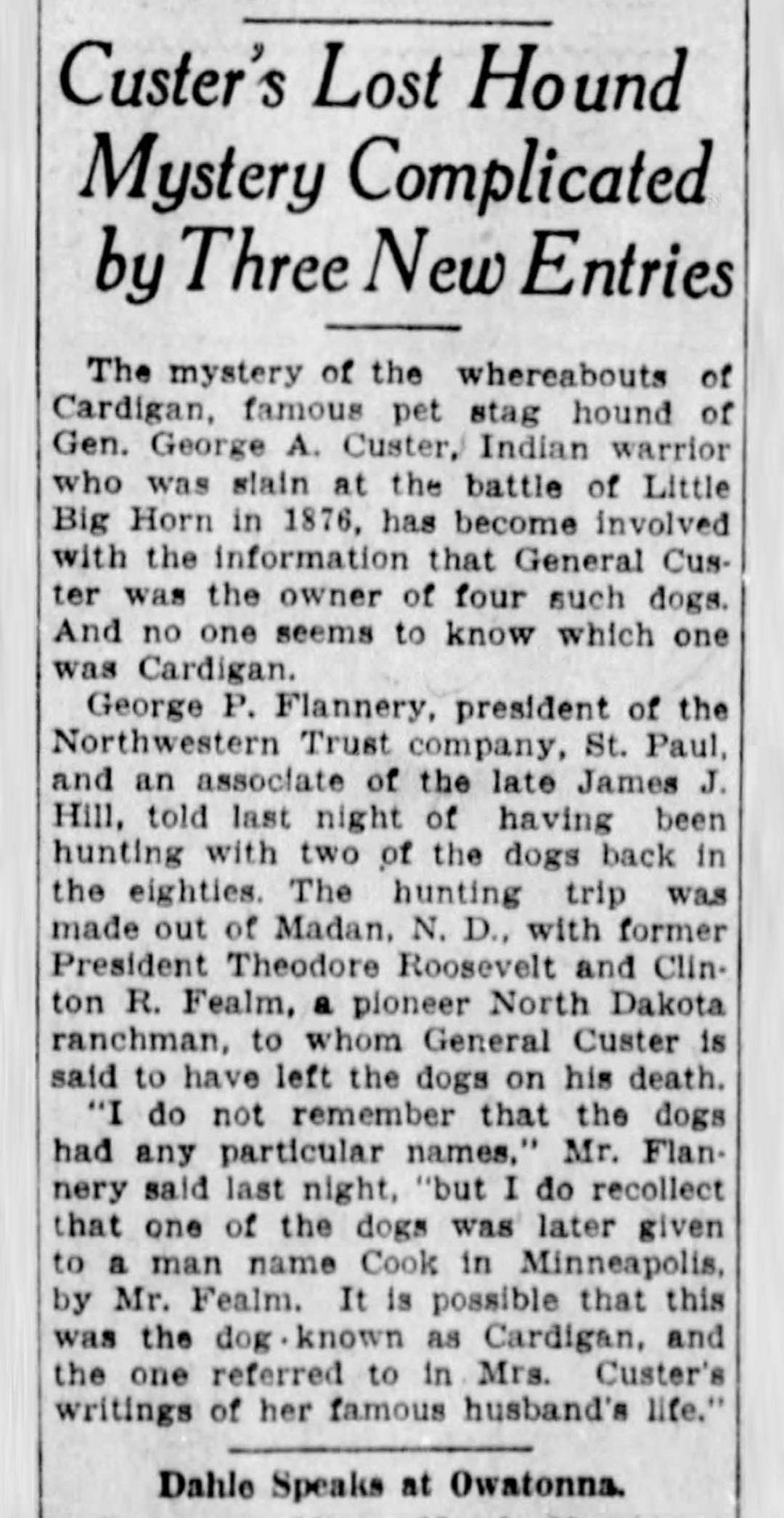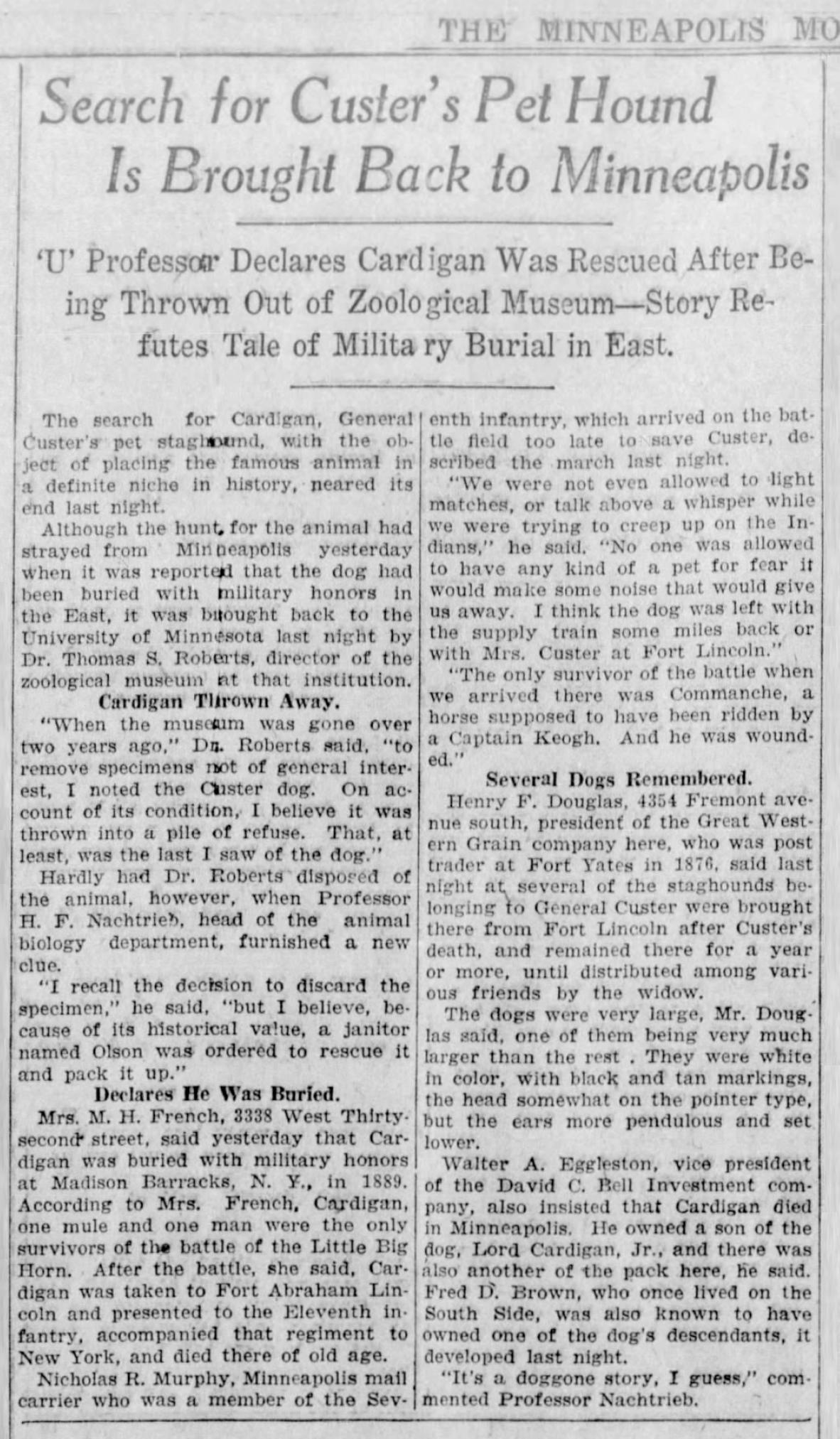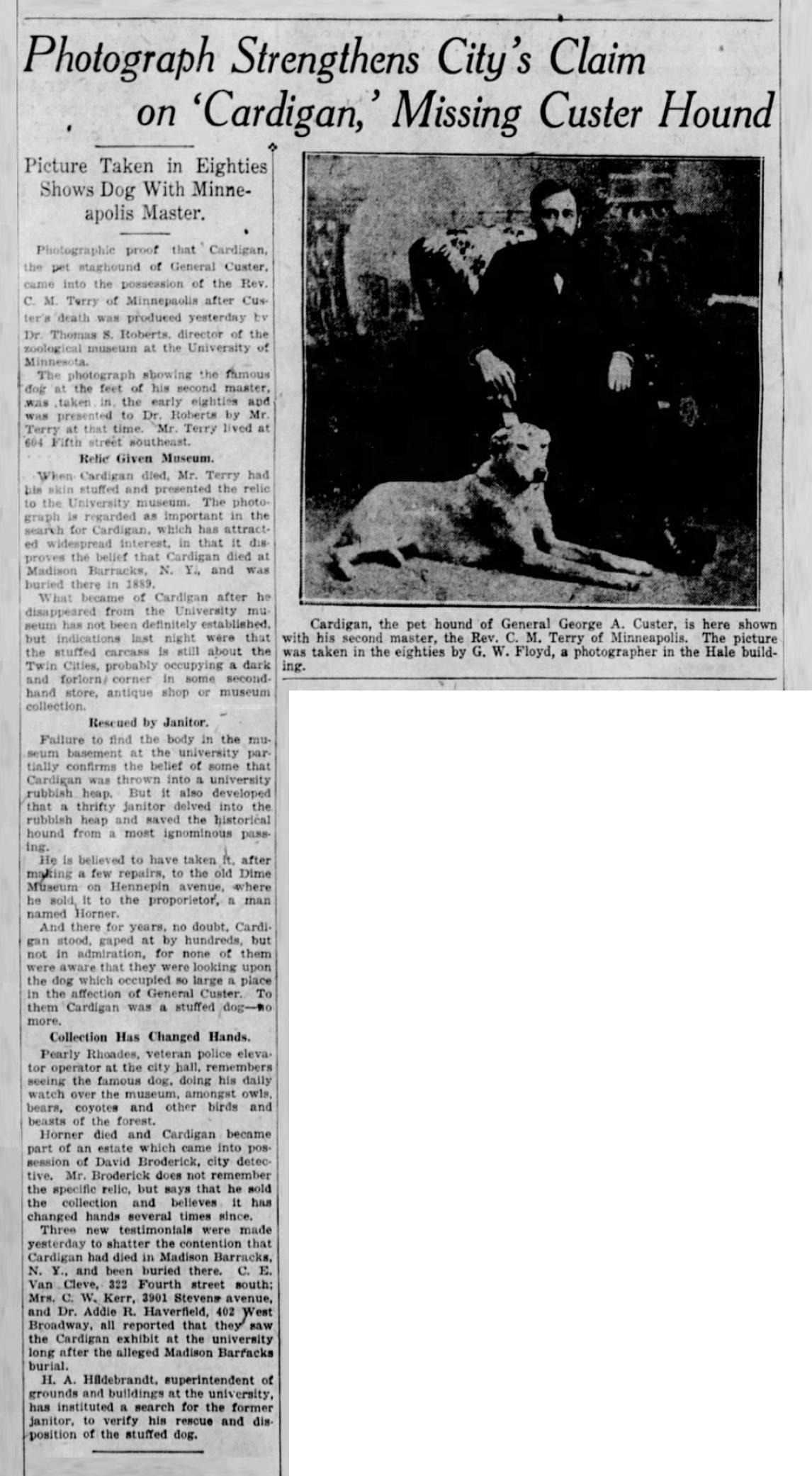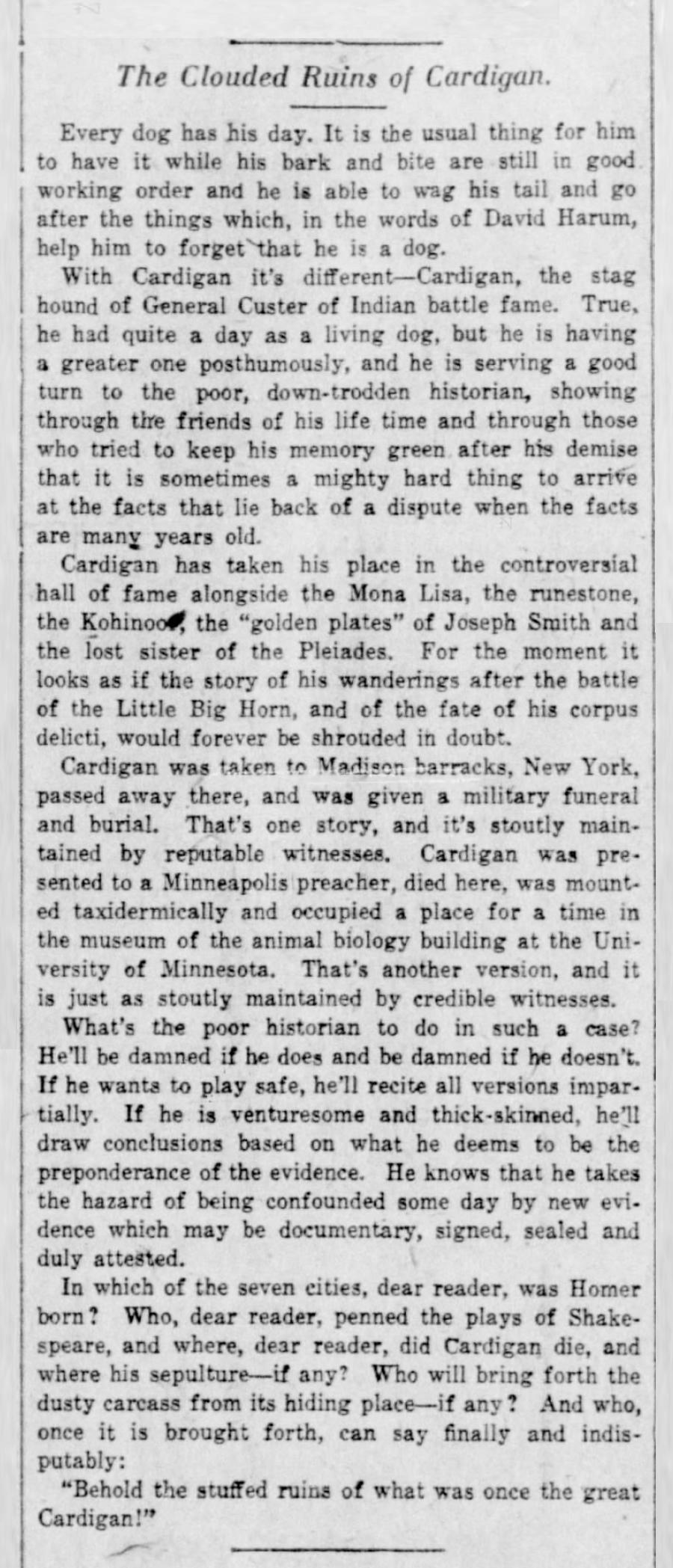Libbie Custer’s account of Cardigan’s death and posthumous time as a display ‘in one of the public buildings in Minneapolis’ was correct although she did not identify the public building. Consequently, rumors abounded with different candidates proposed as Cardigan’s probable sepulcher. On January 8, 1973, the Minneapolis Star suggested in a front-page article that Cardigan’s place of honor had been the city’s public library. In response to an inquiry from Paul Hedren concerning Cardigan’s whereabouts, their reporter, Susan Paulu, reached out to the Minnesota Historical Society.

Cardigan, Custer’s staghound, “probably was moth-eaten and destroyed long ago,” said Donal Empson, reference librarian at the Minnesota Historical Society. Empson and Alan Woolworth, a society chief archeologist, believe that Cardigan was given to the Minnesota Academy of Natural Sciences, a group active in the 1870s and 1880s, ended up in the old Minneapolis Public Library building and later disappeared.
Minneapolis Star 'Column 1' article - January 8, 1973 (link to text)
Based on this information, Hedren subsequently wrote a short article for the Fall, 1974 edition of the Little Big Horn Associate Research Review concerning Cardigan’s fate. It was accompanied by a sketch, created by Lisle Reedstrom, of Cardigan’s mount before an adoring public. Although the sketch was solely the product of Reedstrom’s imagination, it is one of the few known representations of Cardigan.
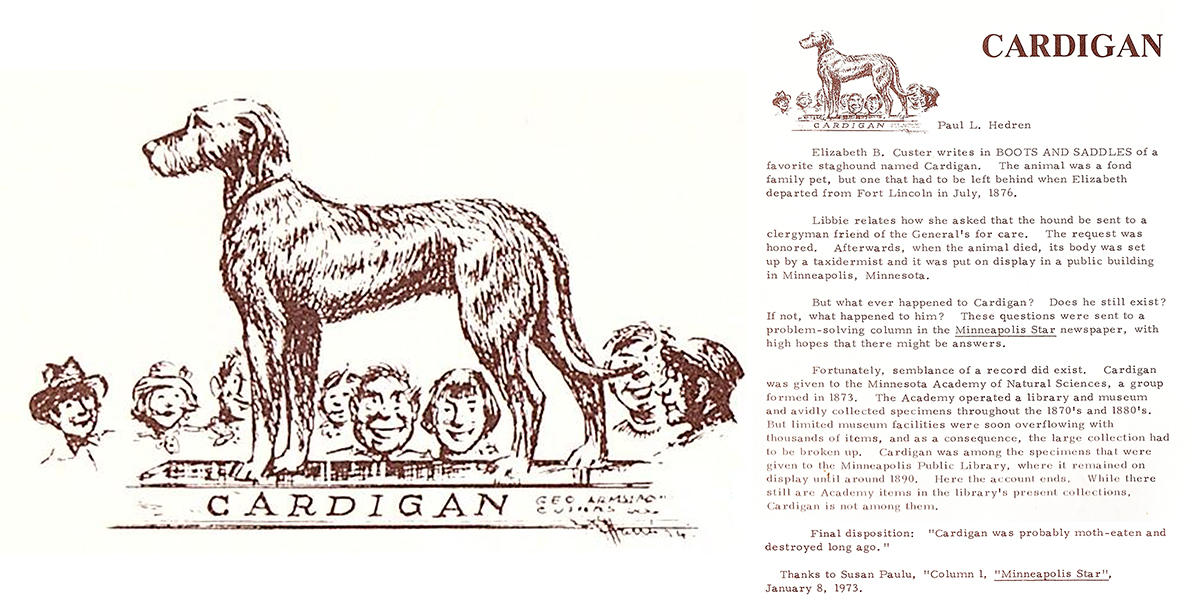
Paul L. Hedron article in Fall, 1974 edition of the Little Big Horn Associate Research Review with drawing of a stuffed Cardigan by Lisle Reedstrom
The 1973 article was not the first time the city’s newspapers had waded into Cardigan waters nor muddied those waters. A half century earlier, the Minneapolis Tribune initiated a week-long series exploring Cardigan’s fate. For three days Cardigan was on the front page, before slipping to the second page and dropping back a dozen pages by the series’ end. The articles were written as if they were an evolving cascade of incoming reports, but clues suggest the somewhat whimsical series was penned out in advance with the goal of entertainment more than education.
The first article on Wednesday, March 21, began with the headings:
Mounted Pelt of General Custer’s Dog Sought Here
‘Cardigan’ Believed to Have Reposed in Old University Museum.
The article initially suggested both that Cardigan’s mount remained ‘somewhere’ in Minneapolis or that the story might be false, before reporting Cardigan had been an unlabeled exhibit in the ‘old University museum’ according to ‘descendants of several pioneers.’ The article concluded by stating: ‘When the museum was moved, many items were disposed of if they apparently had no historical value, and it supposed that this is what happened to the remains of Cardigan.’
The next day’s follow up proclaimed a resolution:
Custer Dog Was in Old Museum Graduate Writes
‘U’ Alumna Says Cardigan’s Stuffed Pelt Stood in Glass Cabinet.
“The mystery of the Custer dog has been solved – almost.
At least a woman graduate of the class of 1885, University of Minnesota, furnished a clue yesterday.
This alumna writes:
“I see in this morning’s Tribune that a search is being made for the Custer dog.
“It belonged to the Rev. C. M. Terry, who, with Mrs. Terry, came West in the seventies and lived with the Rev. and Mrs. E. M. Williams at the corner of Fifth street and Sixth avenue southeast, later the home of Seymour Van Cleve.
“The dog was a pet to the neighborhood and when it died there was much childish grief. The skin was finely stuffed and given to the university, where, later, those of us who ‘twosed’ on the obelisk in the river window in the old museum in the ‘Old Main’ used to see Cardigan standing in state in a glass case.”
Someday I may discover what ‘‘twosed’ on the obelisk’ meant but otherwise the report matches what is often assumed to be accurate of Cardigan’s time in Minnesota. However, the article has a few curious elements. Unlike all the other sources in this week-long series, the woman graduate was unnamed. More importantly, the ‘- almost’ added to the end of the first sentence suggests the subsequent articles were already planned out. Since this article ‘solved’ the mystery, there was no need for ‘almost’ to be added. The word’s presence suggests the writer already knew of the next day’s ‘revelations.’ Most of the articles included ‘responses’ to the previous morning’s edition that somehow arrived in the newsroom in time to shape the next day’s paper rather than arriving over days. Such remarkable postal efficacy suggests most, if not all, of the series was written in advance of the first article’s publication.
Custer’s Lost Hound Mystery Complicated by Three New Entries
Despite the header, the article only describes one new entry, namely that Custer owned four dogs, and no one knew which was Cardigan. As we know, Custer had more than four dogs and the dogs mentioned, even if the article was accurate, were not Cardigan.
On Saturday, the series continued with competing storylines mixing fact, conjecture, and fantasy. One storyline claimed that Cardigan had never been in Minneapolis at all but had remained at Fort Lincoln and later moved with the Eleventh Infantry to New York. There Cardigan died and was buried with military honors at Madison Barracks in 1889. Another begins by quoting Dr. Thomas S. Roberts, the director of the University’s zoological museum, that Cardigan had been at the museum, but two years earlier had been thrown out because of his poor condition. However, the article also quoted Professor H.F. Nachtried, head of the biology department as recalling “because of its historical value, a janitor named Olson was ordered to rescue it and pack it up.” The article ends with a punny quote attributed to Nachtrieb, “It’s a doggone story, I guess.”
Photograph Strengthens City’s Claim on ‘Cardigan,’ Missing Custer Hound
Picture taken in Eighties Shows Dog with Minneapolis Master.
On Sunday, the Tribune wrapped up Cardigan’s story with the above headers and a photograph of Cardigan with Cassius Terry supposedly taken in the 1880s.* While confirming Cardigan’s presence in Minneapolis, the article focused on what became of Cardigan after his time in the General Museum, claiming that Cardigan’s:
‘… stuffed carcass is still about the Twin Cities, probably occupying a dark and forlorn corner in some secondhand store, antique shop or museum collection.’
The article suggested Cardigan was rescued from the trash heap by a thrifty, but now unnamed, janitor who subsequently sold Cardigan to the Old Dime Museum on Hennepin Avenue. After the owner’s death, Cardigan and the museum collection were sold and subsequently lost in the mists of time, with the collection changing hands several times since.
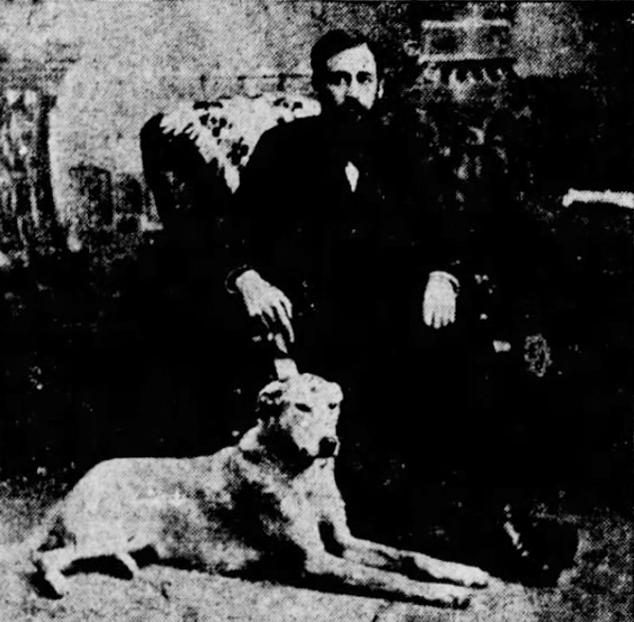
Closeup of only certain photograph of Cardigan with Cassius Marcellus Terry. Although the photograph is often assumed to have been taken in the early 1880s, it was actually taken sometime between late 1876 and early 1879.
A related article on March 31, 1923, in The Austin Daily, identifies the photograph of Cardigan and Terry as being owned by Terry’s great nephew and namesake Cassius Terry, Mower County Treasurer, given to him by Emily Hitchcock Terry twelve years earlier.
After a day’s pause, the series concludes on Tuesday March 27 with an article titled:
The Clouded Ruins of Cardigan
In it, the writer equates the mystery of Cardigan’s whereabouts with “the Mona Lisa, the runestone, the Kohinoor, the “golden plates” of Joseph Smith and the lost sister of the Pleiades” and concludes with overdramatic flair:
“Who will bring forth the dusty carcass from its hiding place – if any? And who, once it is brought forth, can say finally and indisputably:”
“Behold the stuffed ruins of what was once the great Cardigan!”
As it turned out, the University of Minnesota archives held clues of Cardigan’s true fate.


